In a post kindly shared from the Native Hands blog, our basketry specialist Ruby Taylor recounts a recent trip to the woods to make a beautiful ash pack basket.
For ages I’ve been wanting to make a pack, or back, basket. They’re best made in the spring when the sap’s rising, so earlier this year I took a trip to the woods near Bath for a few days to make one.
There’s a long tradition of black ash splint basketry in North America. Anthropologists and historians seem to disagree about the origins of splint wood basketry there, whether it was first introduced by Swedish settlers, or whether there was an existing tradition amongst the First Nations people. This particular technique, of pounding the ash to create splints (as opposed to splitting the wood), is relatively new in the UK. Our native ash species seems to be less pliable for the job than the black ash used in the States, but it still produces great results and is a really appealing technique.

 Our tutor, Andrew Kirby, has already chosen and felled the ash for us. Once the log’s epidermis has been removed by drawknife, pounding begins, over every square inch, in an overlapping pattern (see left).
Our tutor, Andrew Kirby, has already chosen and felled the ash for us. Once the log’s epidermis has been removed by drawknife, pounding begins, over every square inch, in an overlapping pattern (see left).
This crushes the spring growth between the denser summer growth rings. It makes the rings pull away from the log, and these are then lifted carefully off the log in long strips, or splints. The photo to the right shows the layers that have been removed from the log and the one to the left the pounding of the log.
The splints are then shaved smooth with a really sharp knife and cut into the required widths for weaving. It’s a long and laborious job to prep the material, interspersed with much knife re-sharpening…and cups of tea.
As with any basketmaking, the choice and prep of the raw material is critical, and is usually the most time-consuming part. The splints that come off the log are of naturally varying thickness, and these different thicknesses are used in different parts of the basket.
Weaving the base of the pack basket in a cross weave is shown below, then it was on to adding the weavers and shaping the belly of the basket. My work was accompanied by the pungent scent of the carpet of wild garlic and the almost relentless sound of others in the group pounding the ash logs.
As with any basketmaking, the choice and prep of the raw material is critical, and is usually the most time-consuming part. The splints that come off the log are of naturally varying thickness, and these different thicknesses are used in different parts of the basket.
Weaving the base of the pack basket in a cross weave is shown above in the centre, then it was on to adding the weavers and shaping the belly of the basket. My work was accompanied by the pungent scent of the carpet of wild garlic and the almost relentless sound of others in the group pounding the ash logs.
Leather straps cut from a large hide, stitched and riveted together, buckles attached…job done.

It turned out to be four days of hard graft to complete the pack basket. The graft was eased by evening fireside gatherings, a midnight, wood-fuelled, outdoor bath, and the many owl calls at night. It was totally worthwhile for the huge satisfaction of completing my basket. So wonderful to have spent those days living in the woods, weaving.
In North America the black ash, Fraxinus nigra, is under threat from the emerald ash beetle. Here in the UK, ash dieback is having an impact.You can find out more about Ruby, her work and course opportunities in wild basketry, pottery and other crafts via our directory. If you’re interested in learning more about basketry, head on over to our introduction to basketmaking.
 About the author
About the author
Ruby Taylor of Native Hands has been a maker since she was knee-high, and a teacher for over 20 years. She runs popular courses in Wild Basketry and Wild Pottery using foraged materials in the woods. She has experience of a wide range of basketry techniques and also works as part of a team teaching ancient crafts and technologies.

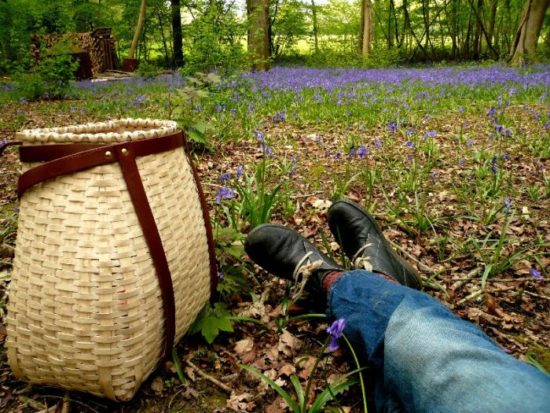


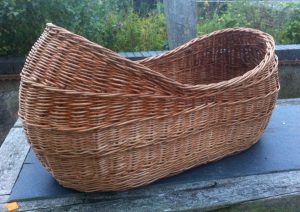
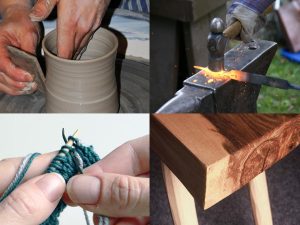
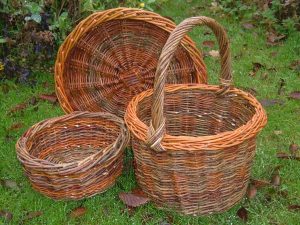
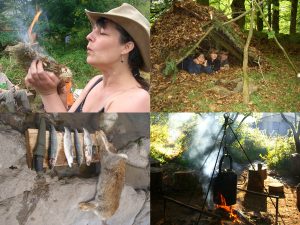

4 Comments
What a thing of beauty and usefulness… ❤️?
Thanks Sasha!
Very common in rural India with Bamboo and Coconut palm leaves.
Yes. back baskets are made all over the world, wherever there’s a basketry tradition. The materials, techniques and design vary from culture to culture, according to what plants grow in the locality